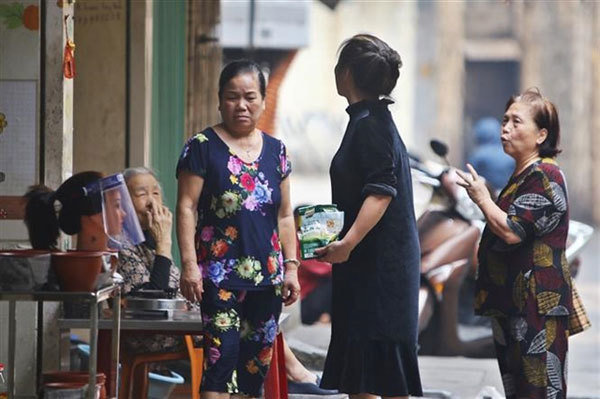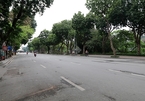 |
| A week since social distancing was put in place, people in Hanoi have become complacent and started gathering in public places. — VNA/VNS Photo Minh Quyet |
But as the number of infected cases of COVID-19 seems to be going down in Vietnam, people have started feeling more relaxed, and the streets are filling up again.
I understand many people have to leave their homes to make a living.
I also understand many might be bored being locking up by themselves during this social distancing phase.
But the fact is the COVID-19 pandemic has shown no signs of abating yet. As of April 9, the coronavirus pandemic had infected more than 1.5 million people. At least 94,000 people have died, and the virus has been detected in at least 177 countries.
It’s crucial to recall these figures at this point in time when there’s no vaccine for the virus. Companies are racing against time to develop one, but a vaccine would take at least 12 to 18 months before it is available. The only tool to fight the spread of COVID-19 now is strictly following social distancing guidelines.
In the past two months, Vietnam has managed to keep the number of cases quite low compared to other countries, regardless of the fact that it shares a border with China, the epicentre of the pandemic. The Government acted quickly to stop international flights, quarantine incoming passengers and isolate all infected cases and anyone they might have come into contact with. Huge efforts by the military, healthcare sectors and others have been made to keep a large part of the population safe.
Part of what is helping is social distancing. This period may even be extended since we haven’t been able to track down the transmission sources of a number of cases. Community transmission has become real.
Many people may think they can simply protect themselves by avoiding those at high-risk or those with symptoms of respiratory illnesses, but it’s not that simple. Studies have shown that many people can carry the novel coronavirus without showing any symptoms, such as fever, dry cough or shortness of breath.
A study by the Huazhong University of Science and Technology in Wuhan, China, said that during the aggressive outbreak in their city, over 50 per cent of cases were non-confirmed, and that these may have included people with no or limited symptoms who had the potential to remain socially active.
Another study in the journal JAMA showed that one person who had no symptoms can actually pass the virus on to five other people. If these individuals continued their social interactions without knowing they were infected, many more people would be at risk.
The Vietnamese Government has predicted more community infections over the next few days related to cases with complicated travelling histories as well as zoned outbreaks at Bach Mai Hospital in Hanoi and Buddha Bar in HCM City.
For these reasons, what we need right now is to continue the full implementation of social distancing to help slow the stealthy spread of this new coronavirus.
Although the health sector said it's prepared for a scenario of 10,000 cases of COVID-19, we wouldn’t want that to happen.
Many of us believe that this virus is doing nothing more than stopping our day to day lives. But for many others working on the front line, it’s much more than that.
Over the past few months, many doctors and nurses haven’t been able to return home to hug their children, to sleep in their beds or have dinner with loved ones. So many soldiers have given up their beds and blankets for people going into quarantine. And many technicians at the Centre for Disease Control and Prevention are working day and night, spending hours and hours in the lab to conduct tests. Many others are having sleepless nights during this battle, whilst bearing a huge workload as they battle to contain the pandemic.
We just can’t ease up too soon and set back all the progress that's been made.
It’s now only a matter of time before scientists discover solutions for the pandemic. We're buying time and trying to slow down the spread of virus when scientists can get the testing done and doctors can get the equipment needed. During this wait, the healthcare system can stem the fatality rate and treat patients using ventilators and intensive care units, if they are available. They can only do that if we don’t allow them to become overloaded with new cases.
Vietnam is taking the time to prepare for different scenarios. If the public takes social distancing seriously, burdening and overwhelming the medical system can be avoided. We don’t know for sure what might happen tomorrow or the next day, but we can slow or stop the spread of the virus and decrease the number of cases. Much of how the coronavirus pandemic unfolds in Vietnam will come down to each person’s choices. Each of us who can limit our social contact can break the chain of the contagion.
For many of us who don’t have to go out to sell food on the street to make a living, for example, staying home and social distancing is a privilege. There’re so many ways to keep yourself from going insane: read a good book, listen to music, cook some good food, bake a cake, clean your home, watch movies, learn to dance, group video chats, and sharing memes!
I understand it might be uncomfortable and lonely staying at home, but we have to think about the collective rather than the individual. We’re not only protecting ourselves by staying at home but also protecting others who are vulnerable to the risks. It might be slow, it might not be perfect, and is socially and economically disruptive, but it can save lives.
Experts predict the virus will be around for quite some time, and it will come in waves. So social distancing might stop for a while and then start again. Until we have a vaccine for it, we need to be patient.
A lesson from the past can be retold in this time of crisis: After authorities in Toronto relaxed requirements for close contact and personal protective equipment after the first wave of the SARS epidemic in 2003, transmissions resurged and the second wave lasted as long as the first one. So we have to be patient to see it through and can’t pull the trigger too early.
Believe me I do want to get out of this mess and back to my normal life just as quickly as you do. Social distancing is an abnormal thing in this connected and integrated world. But if we don’t follow the requirement strictly and stay at home, it might become the new norm. — VNS
Thu Van

Social distancing may be extended if more Covid-19 cases found
Minister and Chairman of the Government Office Mai Tien Dung said on April 8 that social distancing would be reviewed after April 15 and it may be continued if new cases found.

Hanoians speak on the first day of nationwide social distancing
With new nationwide social distancing regulations to help stop the spread of the COVID-19 pandemic coming into force today, life as we know it has changed across the country.
 We’re only entering the tenth day of a two-week nationwide social distancing order in this tough fight against microbial enemies, which are totally new and unpredictable." itemprop="description" />
We’re only entering the tenth day of a two-week nationwide social distancing order in this tough fight against microbial enemies, which are totally new and unpredictable." itemprop="description" />